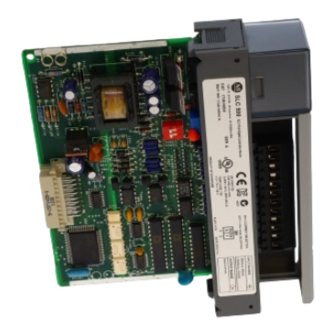
Summarization of Contents
Preface
Who Should Use this Manual
Identifies the intended audience for this manual, focusing on system designers, installers, and programmers.
Purpose of this Manual
Outlines the manual's objective: to explain installation, wiring, and troubleshooting of analog I/O modules.
Related Documentation
Lists other Rockwell Automation documents providing additional information on related products and topics.
Chapter 1 Overview
How to Use Analog
Explains the concept of analog signals and their representation of physical variables in control systems.
Types of Analog Modules
Provides an overview of the different analog modules available for the SLC 500 system.
Chapter 2 Quick Start for Experienced Users
Required Tools and Equipment
Lists the necessary tools and equipment for installing and configuring the analog modules.
Procedures
Details the step-by-step procedures for getting started with analog modules.
Chapter 3 Installing and Wiring Your Analog Module
Determining Your Power Requirements for a Modular Controller
Guides users on calculating power requirements for modular SLC 500 systems using analog modules.
Determining Your Power Requirements for a Fixed Controller
Guides users on calculating power requirements for fixed SLC 500 controllers with analog modules.
Configuring Your Module
Explains how to set the DIP switches on analog modules to configure input channels for voltage or current.
Installing Your Module
Provides instructions on selecting an appropriate slot and physically installing the analog module into the chassis.
Wiring Considerations
Offers essential guidelines for planning and executing system wiring for analog modules.
Minimizing Electrical Noise on Analog Modules
Details methods and best practices for reducing electrical noise interference with analog signals.
Chapter 4 Module Operation and System Considerations
Interface between the Module and the Processor
Describes how analog modules communicate and interact with the SLC 500 processor.
Addressing Analog Modules
Explains how analog input and output channels are addressed within the SLC 500 system's I/O image.
Converting Analog Input Data
Details how analog input signals are converted into 16-bit integer values for the processor.
Converting Analog Output Data
Explains how 16-bit integer values are converted into analog output signals (voltage or current).
Safe State for Outputs
Defines the default output state when the SLC 500 system is not in RUN mode.
Input Channel Filtering
Describes the on-board digital filter used to reject high-frequency noise from analog input signals.
Chapter 5 Testing Your Module
Start-up Procedures
Provides a sequence of steps for testing the analog module after system installation.
Inspect the Analog Module
Details pre-installation checks to prevent problems with the analog module.
Testing Analog Inputs
Guides users through the process of verifying the functionality and accuracy of analog input channels.
Testing Analog Outputs
Guides users through the process of verifying the functionality and accuracy of analog output channels.
Chapter 6 Programming Examples
Addressing, Out-of-Range Detection, and Scaling of Analog Inputs
Demonstrates programming for input addressing, range checking, and scaling analog inputs to engineering units.
Calculating the Linear Relationship
Explains the mathematical equations used to define the linear relationship between input and scaled values.
Using Standard Math
Illustrates programming techniques using standard arithmetic instructions for analog data manipulation.
Using the Scale (SCL) Instruction
Shows how to use the SCL instruction for scaling analog input/output values efficiently.
Using Scale with Parameters (SCP) Instruction
Demonstrates programming with the SCP instruction for flexible scaling of analog data.
Addressing and Scaling Outputs
Covers programming examples for addressing and scaling analog output values.
Scaling Offset when > 32,767 or < -32,768
Explains how to handle large offset values by shifting the linear relationship in programming.
Chapter 7 Maintenance and Safety
Preventative Maintenance
Provides guidance on routine maintenance tasks to ensure system reliability and longevity.
Safety Considerations When Troubleshooting
Highlights critical safety precautions to be observed during troubleshooting procedures.
Appendix A Specifications
General Specifications for NI4, NIO4I, NIO4V, NO4I, and NO4V
Lists general electrical and physical specifications applicable to all analog modules covered.
General Analog Input Specifications for NI4, NIO4I, and NIO4V
Details specific input performance characteristics for NI4, NIO4I, and NIO4V analog input modules.
Voltage Input Specifications for NI4, NIO4I, and NIO4V
Provides detailed voltage input specifications, including range, accuracy, and error limits.
Current Output Specifications for NIO4I and NO4I
Lists specific current output specifications, including range, accuracy, and load requirements.
Appendix B Two’s Complement Binary Numbers
Positive Decimal Values
Explains how positive numbers are represented in 16-bit two's complement binary format.
Negative Decimal Values
Details the representation of negative numbers using the two's complement binary notation.
Appendix C Optional Analog Input Software Calibration
Calibrating an Analog Input Channel
Describes procedures and equations for calibrating analog input channels using software offsets.
Calculating the Software Calibration
Provides the mathematical formulas and steps required to perform software calibration.
Example Ladder Diagram
Presents a sample ladder logic diagram illustrating the software calibration process.
Appendix D Module Input and Output Circuits
Input Circuit for 1746-NI4, -NIO4I, and -NIO4V Modules
Shows the schematic diagram of the input circuitry for NI4, NIO4I, and NIO4V analog modules.
Voltage Output Circuit for 1746-NIO4V Modules
Displays the schematic diagram of the voltage output circuitry for NIO4V analog modules.
Current Output Circuit for 1746-NIO4I Modules
Shows the schematic diagram of the current output circuitry for NIO4I analog modules.















Need help?
Do you have a question about the 1746-NI4 and is the answer not in the manual?
Questions and answers